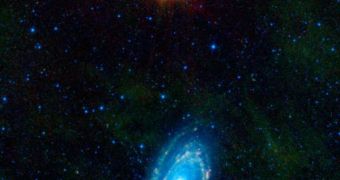Messier 81 and Messier 82 are two nearby galaxies that got to know each other very well a few hundred million years ago, when they swept past each other. The event caused intense spurts of stellar formation to take place in both of the structures.
This tends to happen during galactic collisions, or mergers, or when two galaxies undergo a near-miss-type event. Massive hydrogen gas clouds inside the structures get stirred up by the gravitational and tidal interactions that manifest themselves as galaxies move past each other.
These phenomena take place in both galaxies. If the formations collide, then their gas masses mingle, and millions of fresh, blue stars are formed. This shows on telescope images as bright spots within the galaxies themselves.
The attached image shows M81 and M82 some distance away from each other. But looks can be deceiving. The two bodies are in fact locked in a deadly dance, that will see them colliding and merging with each other millions to hundreds of millions of years ago.
But before that happens, the object will pass by each other several times over, and massive spurts of stellar growth will be triggered every time this happens, or until both exhaust all their gas reserves.
The new view of the two galaxies was collected by astronomers using the NASA Wide-field Infrared Survey Explorer (WISE), which surveys the Universe in four different types of infrared wavelengths.
M82 is the object at the top of the image, represented in yellow hues. It is also known as the Cigar Galaxy, and astronomers recognize it by the massive number of new stars it has at its cores.
“What's unique about the WISE view of this duo is that we can see both galaxies in one shot, and we can really see their differences,” explains the principal investigator of the WISE mission, Ned Wright.
“Because the Cigar galaxy is bursting with star formation, it's really bright in the infrared, and looks dramatically different from its less active companion,” adds the expert, who is based at the University of California in Los Angeles (UCLA).
“The WISE picture really shows how spectacular Messier 82 shines in the infrared even though it is relatively puny in both size and mass compared to its big brother, Messier 81,” adds WISE team member Tom Jarrett, who is based at the California Institute of Technology (Caltech), in Pasadena.
The blue galaxy in the image, Messier 81, is also known as Bode's galaxy, and looks the way it does because it has very little dust. This means that it does not look very bright in infrared wavelengths, despite being bigger than its companion.
In fact, M 81 is one of the brightest galaxies in the sky in visible light, say experts at the NASA Jet Propulsion Laboratory (JPL), also at Caltech. The formation is located some 12 million light-years away from Earth, relatively close-by in astronomical terms.

 14 DAY TRIAL //
14 DAY TRIAL //